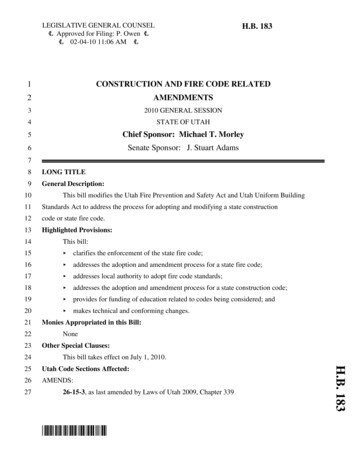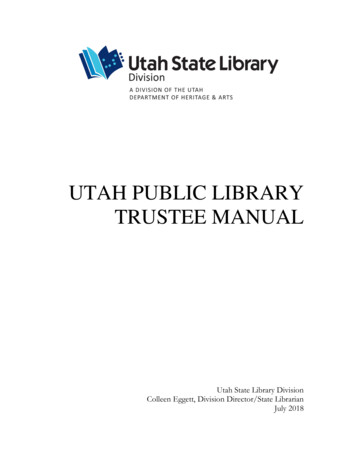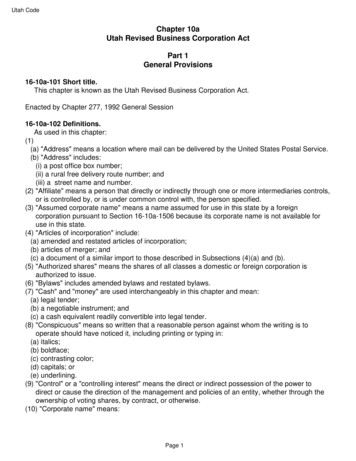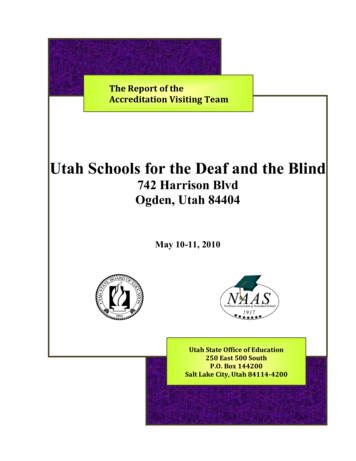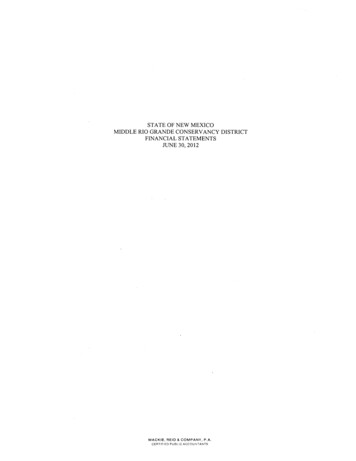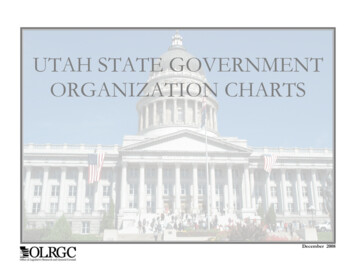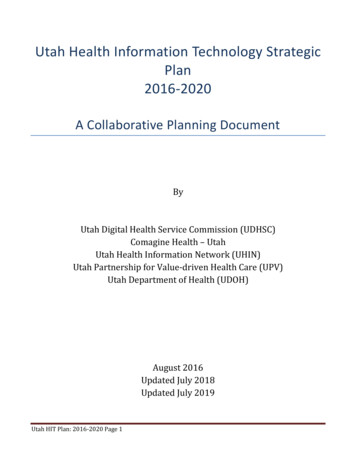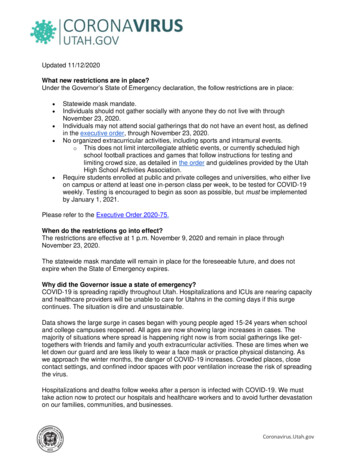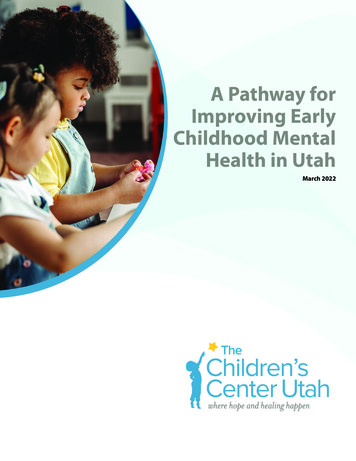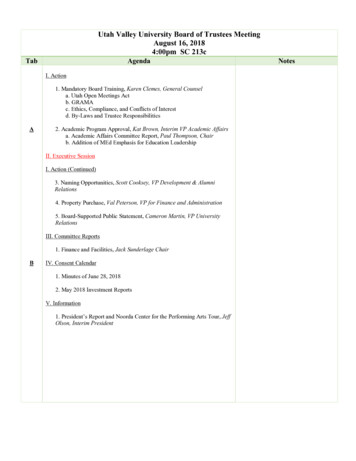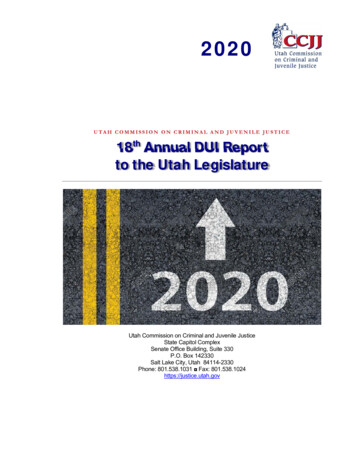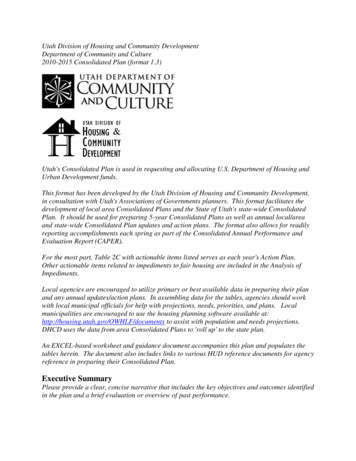
Transcription
Utah Division of Housing and Community DevelopmentDepartment of Community and Culture2010-2015 Consolidated Plan (format 1.3)Utah's Consolidated Plan is used in requesting and allocating U.S. Department of Housing andUrban Development funds.This format has been developed by the Utah Division of Housing and Community Development,in consultation with Utah's Associations of Governments planners. This format facilitates thedevelopment of local area Consolidated Plans and the State of Utah's state-wide ConsolidatedPlan. It should be used for preparing 5-year Consolidated Plans as well as annual local/areaand state-wide Consolidated Plan updates and action plans. The format also allows for readilyreporting accomplishments each spring as part of the Consolidated Annual Performance andEvaluation Report (CAPER).For the most part, Table 2C with actionable items listed serves as each year's Action Plan.Other actionable items related to impediments to fair housing are included in the Analysis ofImpediments.Local agencies are encouraged to utilize primary or best available data in preparing their planand any annual updates/action plans. In assembling data for the tables, agencies should workwith local municipal officials for help with projections, needs, priorities, and plans. Localmunicipalities are encouraged to use the housing planning software available at:http://housing.utah.gov/OWHLF/documents to assist with population and needs projections.DHCD uses the data from area Consolidated Plans to 'roll up' to the state plan.An EXCEL-based worksheet and guidance document accompanies this plan and populates thetables herein. The document also includes links to various HUD reference documents for agencyreference in preparing their Consolidated Plan.Executive SummaryPlease provide a clear, concise narrative that includes the key objectives and outcomes identifiedin the plan and a brief evaluation or overview of past performance.
Consolidated Plan NarrativeCAPER NarrativeThis 2011 edition of the Five County District’sConsolidated Plan marks the fourth five-yearrewrite of the original plan which was firstadopted in 1995 when the U.S. Department ofHousing and Urban Development initiated theconsolidated planning process for federal andstate funding programs. Each year thereafter,until the next five-year rewrite, the plan will beupdated in an Action Plan document with keyinformation to perpetuate the strategic planningprocess.Combining the concerns of large and smallcommunities in the Five County District yieldsa number of regional goals and objectives.These goals and objectives are for communitiesin the region to: Implement effective planningprocesses; Meet the needs and demands of agrowing population; Provide a diversified economy; Promote economic opportunities forlow-to-middle income populations; Preserve cultural and historicalheritage; Protect agricultural lands and localland use traditions; and Maintain a high quality of life inclean, safe, and attractive surroundings.Goals of the Comprehensive EconomicDevelopment Strategy CommitteeThe Comprehensive Economic DevelopmentStrategy Committee of the Five CountyAssociation of Governments was reorganizedin 2006 to meet the organization requirementsof EDA regulations and policies. Thereorganized group met to review and re-directregional economic development efforts. Thefollowing major objectives were approved:1) Provide regionally-focused services that
complement county and community economicdevelopment programs. Specific servicesinclude: Revolving Loan Fund marketing andadministration across the region, ratherthan establishing other county orcommunity-scale loan programs. Preparation of project-levelEnvironmental Assessments within thecapacity of available staff resources. Delivery of technical planningassistance regarding workforce housingdesign and construction. Development and delivery of up-todate land use planning trainingmodules. Author planning and feasibilitystudies for projects that transcendcounty or community boundaries asdirected by the Steering Committee.Examples include scenic bywaycorridor management plans, regionalhazard mitigation plans, and theregional Consolidated Plan. Maintain a dynamic and informativeInternet web page. Continue to provide high qualitygrant writing and technical assistance tojurisdictions in southwestern Utah.2) Focus efforts on jurisdictions that do nothave internal staff support to provide day-today economic development outreach. Specificactivities include: Respond to leads from the EconomicDevelopment Corporation of Utah. Add information to the Sure Sites
program. Participate in regional and state-wideinitiatives such as Utah Small Cities,Inc., Utah Economic Alliance,Governor’s Rural Partnership Board,etc.3) Represent southwestern Utah interests atforums such as: Western Region Workforce ServicesCouncil Color Country RC&D Council Heritage Highway 89 Alliance Scenic Byway 12 Committee Nature’s Patchwork Parkway(Highway 143) Committee Canyon Region EconomicDevelopment Alliance Grand Staircase-Escalante NationalMonument Advisory Committee County and community-levelEconomic Development Boards. Forge closer ties between economicdevelopment and public/highereducation initiatives in the region.4) Champion regional projects that fostereconomic development, such as: Extending commercial powercapacity to Ticaboo/Bullfrog Provide IT/Broadband redundancyacross the region Establishing access to land banking,
secondary financing, and otheractivities that foster access ofaffordable workforce housing. Provide public lands planningexpertise and capacity to local officials.Past Goals and Policies Still in Effect1) Encourage a Business Climate that willContinue toAttract Diverse NonPolluting Industries.2) Diversity the Economic Base so thatAdverse Economic Conditions Affecting OneIndustry will not Significantly Impact theLocal Economy as a Whole.3) Provide the Types of Employment that willStem Out-Migration and will Stimulate ReMigration.4) Develop the Region’s Natural Resources,Especially Timer, to the Extent Possible whileEncouraging the Employment of LocalCitizens and the Establishment of PermanentFacilities which will Increase the Tax Base.5) Retain the Agricultural and GrazingSectors as Necessary Elements of the Region’sEconomy.6) Continue to Develop and Expand theRecreation and Tourist Industries.7) Utilize the Movie Industry to an Advantageby Encouraging the Location of FixedFacilities for Movie Production and HiringLocal Residents to the Maximum Extent.8) Assist and Encourage Firms to Locate inEstablished Industrial Parks and Areas thatwould use Municipal Services, TransportationAccess, etc. Aggressively Pursue theDevelopment of Potential IndustrialParks/Areas for Communities of Beaver,
Kanab and Panguitch.9) Continue the Increase in ManufacturingEmployment in the Region.10) Continue the Support of Existing and NewIndustrial Development Boards at Local andRegional Levels to Guide DevelopmentActions and to Insure Policy Input fromElected Officials and Citizens.11) Provide an Effective CommunicationsProcess Among all Boards and Citizen Groupsin the Region.12) Industrial Development Efforts in theRegion should be Carefully Coordinated toMaximize Related Efforts and to EliminateDuplication or Unnecessary CompetitionAmong Boards or Communities.13) Data Collection and Analysis Must Focuson Review and Reorganization of ExistingInformation when Possible Rather thanWasting Resources on New Studies.14) Data on the Five County Region will beAnalyzed to Identify Possible TargetIndustries. Refined Data will be Submitted tothe Respective County Economic DevelopmentBoard for Screening and Determination of theBest Economic Fit.15) Each Targeted Industry should have anIdentification Market Plan Developed thatDetails the Local Strategy for IndustrialExpansion Related to that Industry.The regional priorities of the Five CountyAssociation of Governments relating tohousing include the administration of downpayment assistance programs, rehabilitation ofdeteriorated housing stock, rehabilitation ofexisting rental units, providing betteravailability of safe and adequate affordablerentals, providing seasonal rental housing to
support the tourism industry, and developingmore water and sewer capacity for housingdevelopment in high growth areas.In coordination with the State of Utah's TenYear Plan to End Homelessness, by the year2014, the Five County area agrees that the goalis "every person within southwest Utah willhave an equal opportunity to access safe,decent, affordable housing with the neededresources and support for self-sufficiency andwell-being." The "Housing First" approach formost families is the most advantageoussolution for homelessness. The focus in thisapproach is to provide homeless individualsand families a prompt, accessible pathway intohousing and connections with appropriatemainstream services. This process reduces theamount of time an individual or family ishomeless to an absolute minimum.The priorities established historically by theelected officials in southwestern Utah whoserve as the rating and ranking committee havefocused almost exclusively on brick and mortartype projects and housing related activities.This appears to be quite consistent with theidentified needs of communities: Housingrehabilitation, renovation, and orreconstruction as well as basic infrastructureand community facilities, i.e. fire stations, etc.Citizen ParticipationPlease provide a concise summary of the citizen participation process, a summary of any citizencomments or views on the plan, and efforts made to broaden public participation in thedevelopment of the Consolidated Plan, including outreach to minorities and non-Englishspeaking persons, as well as persons with disabilities. The summary of citizen comments mustinclude a written explanation of comments not accepted and the reasons why these commentswere not accepted. The narrative should also address citizen input into the funding prioritydecision making process.Consolidated Plan NarrativeThe Five County Association of Governmentsconsulted with numerous organizations andgroups in development of the Five YearCAPER Narrative
Consolidated Plan and the 2011 Action Plan toevaluate needs and accomplishments.Information is disseminated to over 300individuals utilizing the AOG's newsletter, postcards are mailed to various agencies andindividuals seeking comment as well as anadvertised public hearing held in conjunctionwith the January Steering Committee meeting.A primary purpose of the AOG is to coordinatefederal, state and local programs acrosssouthwest Utah regarding the AOG, includingthe consolidated planning process.The largest and most comprehensive publicinvolvement tool used in the region is theannual Public Forums which are held in thespring of each year. A session is conducted ineach of the five counties. Staff from both thehuman services and community and economicdevelopment conduct the sessions designatedto elicit the most pressing needs of localofficials and the public.Information was presented and input solicitedfor the Consolidated Plan in communitydevelopment and housing efforts. Extensiveefforts are employed to bring out not onlyagency staff, but also clientele of social serviceagencies and programs and residents with noparticular connection beyond their interest inlocal programming.Topics of these forums cover approximately 40categories, including adequate and/oraffordable housing, community development,economic development, health care needs,transportation, special needs issues for disabledand elderly individuals, emergency fooddistribution, substance abuse, energy andtechnology, etc.
Other Agencies ConsultedList other public/private entities that were consulted in developing this plan.Consolidated Plan NarrativeInformation and data from non-profitorganizations which provide services to lowincome clientele were utilized in developmentof the Consolidated Plan. These include: Area Agency on Aging services whoprovided information on the needs andprograms of the senior populations; Southwest Utah Mental HealthAuthority; Erin Kimball Foundation; Cedar City Housing Authority; Beaver City Housing Authority; Paiute Indian Tribe Housing Authority; St. George Housing Authority; Color Country Community Housing,Inc., who provided technical supportand data on developing affordablehousing; The Five County Human ServicesCouncil, including coordination withlocal emergency food and shelter boardprogram efforts provided in the FiveCounty region; Youth Corrections; Division of Child and Family Services; Elderly care facilities and providers; The city of St. George CommunityDevelopment Staff in regard toentitlement funding received from theCommunity Development Block Grantprogram. Data was also gathered from theContinuum of Care, Balance of State.Various packets were distributed tojurisdictions in the Five County regionfor assistance in updating their capitalimprovements lists, housing stockcondition survey, and communityassessments.CAPER Narrative
Table 1- Housing, Homeless and Special Needs Assessment (Required forConsolidated Plan)Using the local Affordable Housing Plan(s) and other available data, please complete the HUDrequired Table I in the attached EXCEL-based document. That EXCEL-based documentautomatically populates the table below.Once you are within the EXCEL-based document, HUD information for completing Table 1 isavailable by clicking on the box labeled "Table 1 Housing, Homeless and Special NeedsAssessment". Software for projecting affordable housing needs is available through the Divisionof Housing and Community Development at: ion on homeless populations can be derived from local homeless coordinatingcommittee's projections and data.
Table 1 Housing,Homeless andSpecial NeedsAssessment(Required forConsolidated Plan)A. Table I - HousingNeedsHousehold TypeElderly Renter(1&2 personhousehold,either person 62years old orolder)Small(2-4 members)Large(5 members)All OtherTotal RenterOwner0 –30% of MFI3,8844038443036712,2211,663%Any housing 3,5356,567%Cost burden 30%325.1%Cost Burden 50%223.731 - 50% of MFI5,672%Any housing problem281.8%Cost burden 30%228.2%Cost Burden 50%87.251 - 80% of MFI%Any housing problemTotalHouseholds10,102170.4
15.624.246.743.6130.140.3%Cost burden 30%110.714.113.211.934.974.136.6%Cost Burden 50%18.03.00.40.24.4B. Table I - HomelessContinuum of Care:Housing Gap 1353216858-4676-405-40139-126TotalPersons in FamiliesWith manentSupportiveHousingTotal8.010.0
C. Table I - Continuumof Care: HomelessPopulation andSubpopulations ChartPart 1: HomelessPopulationNumber of Families withChildren (FamilyHouseholds)1. Number of Persons inFamilies with children2. Number of SingleIndividuals and Persons inHouseholds without Children(Add lines Numbered 1 & 2Total Persons)Part 2: ansitional3231632656UnshelteredTotala. Chronically Homeless5243288b. Seriously Mentally Ill25252626c. Chronic Substance Abused. Veteranse. Persons with HIV/AIDSf.Victims of DomesticViolenceg. Unaccompanied Youth(Under 18)D. Table 1 - Housing,Homeless and SpecialNeeds-
Special Needs (NonHomeless)Subpopulations1. Elderly2. Frail Elderly3. Severe Mental Illness4. DevelopmentallyDisabled5. Physically Disabled6. Personsw/Alcohol/Other DrugAddictions7. Persons w/HIV/AIDS8. Victims of DomesticViolence9. OtherUnmet Need(renters andowners)
Table 2A – State Priority Housing Activities/Investment PlanUsing the data from Table 1 and local housing plans please prioritize the populations foractivities and allocation of funds in the attached EXCEL-based document. That EXCEL-baseddocument automatically populates the table below.Once you are within the EXCEL-based document, HUD information for completing this table isavailable by clicking on the box labeled "Table 2A".Table 2A (OPTIONAL TABLE)State Priority Housing Activities/Investment PlanPART 2 PRIORITY HOUSINGNEEDSHousehold SizeSmall (5persons or lesswith 2 relatedpersons)Large (5persons orlarger with atleast 2 relatedpersons)Rental UnitsElderlyAll OtherOwner Occupied UnitsPriority LevelIndicate High (3),Medium (2), Low 80%PART 2 PRIORITY SPECIALNEEDSElderlyFrail ElderlySevere Mental IllnessDevelopmentallyDisabledPhysically DisabledPriority LevelIndicate High (3),Medium (2), Low (1)HHHHH
Persons w/ Alcohol/Other DrugAddictionsPersons w/HIV/AIDSHMVictims of Domestic ViolenceYouth Aging Out of Foster CareOther:PART 3 PRIORITYHOUSINGACTIVITIESHHPriority LevelIndicateHigh (3),Medium (2),Low (1)CDBG Priorities1. Acquisition of existingrental unitsH2. Production of newrental unitsH3. Rehabilitation ofexisting rental unitsH4. Rental assistanceL5. Acquisition of existingowner unitsL6. Production of newowner unitsL7. Rehabilitation ofexisting owner unitsL8. HomeownershipassistanceLHOME Priorities1. Acquisition of existingrental unitsL2. Production of newrental unitsL3. Rehabilitation ofexisting rental unitsL4. Rental assistanceL5. Acquisition of existingowner unitsL6. Production of newowner unitsL
7. Rehabilitation ofexisting owner unitsL8. HomeownershipassistanceLPART 3 PRIORITYHOUSINGACTIVITIES(Continued)Priority LevelIndicateHigh (3),Medium (2),Low (1)HOPWA Priorities1. Rental assistanceL2. Short termrent/mortgage utilitypaymentsL3. Facility based housingdevelopmentL4. Facility based housingoperationsL5. Supportive servicesL6. OtherOther Populations1. Unaccompanied youthL2. Other dischargedindividuals (incarceration,etc.)L3. Homeless populationsLOther CommunityNeeds1. Community Facilities(libraries, communityhalls, etc.)H2. Culinary Water3. PlanningHH
4. EconomicDevelopmentH5. Removal of Barriersfor the DisabledL6.7.8.9.HMHLSewer SystemsTransportationStreetsParks and Recreation:10. Public Safety11. Public Services12. Other:13. Other:HM
Table 2C – Summary of Specific Objectives (Actions)Using the data from Tables I and 2A along with local housing plans, please list specific measurable objectives and funding allocations in the attachedEXCEL-based spreadsheet that help meet the prioritized needs from Table 2A. Agencies should include an expected number of measureable units to beaccomplished for each of the five years. Once within the EXCEL-based document, HUD information for completing this table is available by clicking on thebox labeled "Table 2C Summary of Specific Objectives". Overall objectives listed in the EXCEL document have been prepared by DHCD to align with theHUD Strategic goals and Utah’s "Analysis of Impediments" (AI). The EXCEL-based document automatically populates the table below. Future projectionscan be revised each year during preparation of the annual update and action plans. Actual numbers accomplished are assembled by the state for the annualCAPER.Table 2C Summary of Specific Objectives (Actions)Outcome/ObjectiveSpecific Obj. #DH-1DH-1.1HUD 2010-15Strategic ObjectiveSpecific Objectives met with proposed(Actions)actionFor Annual CAPER RAnalysis ofImpediment metwith proposedactionSources ofIndicate High Funds (CDBG,(3), Medium HOME, HOPWA,(2), Low (1)ESG, other)ProposedAllocation ofHUD ActualNumber(forState useonly)ExpectedNumberPerformanceIndicatorsState FiscalYearAvailability of Affordable HousingProvide fully-accessiblerental housing: 1)TURN; 2) SouthwsestMental Health.HHOME & StateMatchHOME & StateMatchHOME & StateMatch51,000 Householdsassisted (newSF and MF unitsfor personshaving physicaldisabilities)2010201132012HOME & StateMatch2013HOME & StateMatch201424MULTI-YEAR GOALDH-1.2Provide housing forhouseholds with specialneeds (mental illness,seniors, etc.): 1) CedarCity Housing AuthorityHOWHLFLIHTC32,500 Number of new92,500 units funded20102011USDA RD475,0002012CDBG300,0002013242014HOME & StateMatchMULTI-YEAR GOALDH-2DH-2.1Affordability of Decent HousingDevelop moreaffordable rentalhousing: 1) Erin KimballMemorial Foundation;2) Beaver HousingAuthority; 3) Cedar CityHousing Authority; 4)Cour CountryH201041201116OWHLF570,925 Households871,161 assisted (newunits)469,658CDBG900,0002013Other648,548USDA RDLIHTC20122014MULTI-YEAR GOAL24
DH-2.2Provide housingsolutions to end chronichomelessness: 1) IronCounty Care & 00Number of newunits funded20102011322012HOME & StateMatch2013HOME & StateMatch2014MULTI-YEAR GOALDH-2.3Increasehomeownershipopportunities for lowincome families: 1)Cedar City HousingAuthority Counceling;2) CCCHI (2010 12self help and 2 DH-2.4DH-2.5Provide housing forhouseholds withHIV/AIDS (throughTenant Based RentalAssistance; Facilitybased HousingAssistance; and Shortterm Rent, Mortgageand Utility Assistance).Increase capability oflocal agencies to planand develop housingprojectsHOPWAHOPWAHOPWA7,200,000 Number of newhomes created9,120,000 (DPA, Self 47201125201240201357201412MULTI-YEAR GOAL# of householdsserved MULTI-YEAR GOALCDBG/HOMECDBG/HOMECDBG/HOMENumber ofworkshops andformal E2014MULTI-YEAR GOALDH-2.6Prevent homelessnessthrough rentalassistance: 1)Southwest BehavorialHealth Center 40,000per yearHHUDESG and matchESG and match40,000 # of householdsserved withrentalassistanceESG and match2010201120122013ESG and match2014MULTI-YEAR GOALDH-3DH-3.1Sustainability of Decent HousingPreserve moreaffordable housingCDBG/HOME &StateMatch &CDBG/HOMEStateMatch &CDBG/HOMEStateMatch &CDBG/HOMEStateMatch &CDBG/HOMEState MatchHouseholdsassisted (MFunits preservedand rehabilitatedincluding leadbased paintabatement)MULTI-YEAR GOAL20102011201220132014
ty of Suitable LivingEnvironmentProvide more andupgraded publicfacilities primarilybenefiting low-incomecitizens: 1) HatchTown CommunityCenter; 2) EscalanteFire Station; 3)Sustainability of Suitable Living EnvironmentProvide safe and cleanwater, primarily to lowincome persons, toimprove thesustainability of thecommunity: 1) HildaleCityHHCDBG (2010)CDBG (2011)CDBGCDBGCDBG679,185 (LMI) persons182,000 served throughincreasednumber offacilities R GOALCDBGHCDBG (2011)(LMI) persons150,000 being EAR GOALProvide warm and safeshelter for the homelessESG and matchShelter nights2010ESG and match2011ESG and match2012ESG and match2013ESG and match2014MULTI-YEAR GOALSL-2.3Remove barriers todisabled personsutilizing public facilitiesCDBGCDBGCDBGDisabledpersons beingservedCDBG2010201120122013CDBG2014MULTI-YEAR GOALSL-2.4Provide other publicinfrastructureimprovementsCDBGCDBG(LMI) personsbeing served20102011CDBG2012CDBG2013CDBG2014MULTI-YEAR GOALEO-1EO-1.1Availability/Accessibility of EconomicOpportunityCreate economicopportunity: 1) FiveCounty RLF Fund LoanClosings.HHCDBG/EDA/USDACDBG/EDA/USDANumber of DBG/HOME2014MULTI-YEAR GOALEO-1.2Support services toincrease self sufficiencyfor the homelessESG and matchESG and matchHours of casemanagement20102011ESG and match2012ESG and match2013ESG and match2014MULTI-YEAR GOAL
EO-2EO-2.1Affordability Economic OpportunityIncrease availableaffordable units ofworkforce housingHOMEHOMENumber of YEAR GOALEO-3EO3.1Sustainability of Economic OpportunityInsure that projectssupport LMI populationsHOMEHOMEHOMEAverage AMIserved EAR GOALCR-1CR-1.1Community RevitalizationPlan for bettercommunities andutilization of fundsCDBGCDBGCDBGNumber of LTI-YEAR GOAL
Narrative 1 Lead Based PaintEstimate the number of housing units that are occupied by extremely low, low, and moderateincome residents that contain lead based paint hazards, as defined in section 1004 of theResidential Lead Based Paint Hazard Reduction Act of 1992. Describe how lead issues will bemitigated in structures receiving HUD funds for rehabilitation?Consolidated Plan NarrativeLead Based Paint PolicyIt is the policy of the Five County Associationof Governments to test only homes that werebuilt prior to 1978.The Home and Weatherization Programs testonly those areas that might be disturbed duringweatherization or rehabilitation activities todetermine if lead safe work practices must beimplemented.If the lead is found, employees of the agencyand any sub-contractor will be certified to dolead safe work practices.The home owner will be notified and will begiven a Protect your Family from Lead in YourHome brochure.All homes built prior to 1978 will receive thisbrochure even if there are no surfaces beingdisturbed.The following narrative describes the leadbased pain issue in Southwestern Utah andprovides additional information:Lead Based PaintLead poisoning is one of the most common andpreventable health hazards to children today.Research indicates that even a low level of leadin a child’s blood can have harmful effects ontheir physical and developmental health. Themost common source of lead poisoning isexposure to lead-based paint, usually in achild’s home. Lead exposure occurs whenchildren ingest chips of lead-based paint, paintcontaminated dust, paint contaminated soil, orCAPER Narrative
inhalation of lead-based paint dust particles(usually occurring from home renovation, ormaintenance). Lead-based paint hazards aredefined as any condition that causes exposureto lead which would result in adverse humanhealth effects. Typical exposure comes fromlead-based paint dust, lead-based paintcontaminated soil, and lead-contaminated paintthat is deteriorated or present in accessiblesurfaces, friction surfaces, or impact surfaces.Estimation of housing units in southwesternUtah which may contain lead based paintAny housing built before 1978 is considered tobe at risk for containing some amount of leadbased paint. Older housing is more likely tohave lead-based paint; the amount of lead inthe paint tends to increase with the age of thehousing. Data acquired from the 2000 U.S.Census and 2008 American CommunitySurvey illustrates that 44.1% (average) of theFive County region housing stock was builtbefore 1978. At 64.6%, Beaver County has thehighest percentage of housing stock builtbefore 1978; at 16.6% Washington County hasthe lowest percentage. In sum, 44.1% of theregions housing stock was built before 1978;by default this housing stock has a higherpotential for the presence of lead-based paint.Estimation of housing units in southwesternUtah occupied by LMI which may containlead based paintThe 2000 U.S. Census and 2008 AmericanCommunity Survey illustrates that the FiveCounty region contains 68,382 housing units;of this amount, approximately 41.1% are lowto moderate-income households. In effect,approximately 2/5 of the region’s population isclassified as LMI. Since low- to moderateincome people often live in older housing, theypossess a higher risk for exposure to leadbased paint exposure.
Lead based paint strategyIn an effort to reduce lead based paint hazards,Five County could consider implementing thefollowing: Collaborate with State and localagencies, nonprofit groups, and theprivate sector to reduce housing relatedlead based paint hazards, especially forlow-income families and children. Ensure that applicable building codesand regulations, as applies to lead basedpaint, are implemented throughconscious inspection proceduresperformed by related departments. In regards to the two Down PaymentAssistance Programs that Five Countyadministers, ensure that homeownerswho purchase structures built before1978 receive: a “Protect Your Family fromLead in Your Home” brochure. a Seller’s Disclosure of anyknown information concerningLBP or LBP hazards. any Records and reports on LBPand/or LBP hazards which wereavailable to the sellers. an attachment in each purchasecontract which included a LeadWarning Statement; and Each buyer is provided a 10-dayperiod to conduct a paintinspection or risk assessmentfor lead based point hazard inthe home.Through proper implementation of the itemslisted above, an additional level of assurance isafforded to the long term health and stability ofchildren who are living in housing which mayhave the potential for the presence of leadbased paint.Data Source used: U.S. Census Bureau, 2008 AmericanCommunity Survey & 2000 Decennial Census
Narrative 2 - Market ConditionsDescribe the significant characteristics of the housing market in terms of the supply, demand,condition, and the cost of housing.1Consolidated Plan NarrativeIn regards to the regional housing market, thecurrent economic climate has exhibiteddramatic increases in foreclosure activity aswell as stagnation in new construction.CAPER NarrativeMarket ConditionsIn comparison of the regional housinginventory for years 2000 and 2008, the FiveCounty region has experienced a 31.3%increase in housing inventory during theaforementioned timeline. Washington Countyexhibited the highest amount of housinginventory increase, totaling 54.9%.VacancyWith regard to vacancy, the Five Countyregion has a large number of units classified asvacant. Th
Utah Division of Housing and Community Development Department of Community and Culture 2010-2015 Consolidated Plan (format 1.3) Utah's Consolidated Plan is used in requesting and allocating U.S. Department of Housing and Urban Development funds. This format has been developed by the Utah Division of Housing and Community Development,
